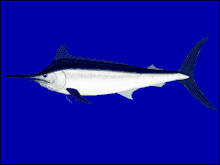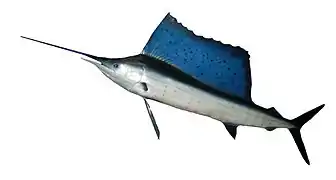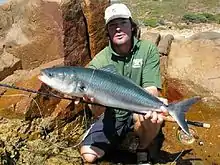Black marlin
The black marlin (Istiompax indica) is a species of marlin found in tropical and subtropical areas of the Indian and Pacific Oceans.[2] With a maximum published length of 4.65 m (15.3 ft) and weight of 750 kg (1,650 lb),[2] it is one of the largest marlins and also one of the largest bony fish. Marlin are among the fastest fish, but speeds are often wildly exaggerated in popular media, such as reports of 120 ft/s (82 mph).[3] Recent research suggests a burst speed of 36 kilometres per hour (22 mph) is near the maximum rate.[4] Black marlin are fished commercially and are also a highly prized game fish.
| Black marlin | |
|---|---|
 | |
| Scientific classification | |
| Kingdom: | Animalia |
| Phylum: | Chordata |
| Class: | Actinopterygii |
| Order: | Istiophoriformes |
| Family: | Istiophoridae |
| Genus: | Istiompax Whitley, 1931 |
| Species: | I. indica |
| Binomial name | |
| Istiompax indica (G. Cuvier, 1832) | |
| Synonyms | |
|
List
| |
Description
Compared to striped or white marlins and sailfish, black marlins are more solid than their blue counterparts. They have a shorter bill and a rounder and lower dorsal fin. Black marlin may be distinguished from all other marlin species by their rigid pectoral fins, which, especially from a weight of around 68 kilograms (150 lb), are unable to be pressed flat against their sides.
–Novelist Ernest Hemingway from To Have and Have Not (1937)[5]
_(AM_MA36484-25).jpg.webp)
Distribution
The species occurs in the tropical and subtropcial Indo-Pacific, with uncommon movements into temperate waters, and rare reports from the Atlantic.[2]
Diet
Diet mostly consists of various fish and cephalopods. They may eat tuna, mackerel, snake mackerel, flying fish, squid, crustaceans, octopus, etc.[2]
See also
References
- Collette, B.; Acero, A.; Canales Ramirez, C.; et al. (2011). "Istiompax indica". The IUCN Red List of Threatened Species. IUCN. 2011: e.T170312A6742465. doi:10.2305/IUCN.UK.2011-2.RLTS.T170312A6742465.en.
- Froese, Rainer and Pauly, Daniel, eds. (2013). "Istiompax indica" in FishBase. April 2013 version.
- BBC Worldwide (27-05-2008). Black marlin - the fastest fish on the planet. Ultimate Killers - BBC wildlife.
- Svendsen, Morten B. S.; Domenici, Paolo; Marras, Stefano; Krause, Jens; Boswell, Kevin M.; Rodriguez-Pinto, Ivan; Wilson, Alexander D. M.; Kurvers, Ralf H. J. M.; Viblanc, Paul E.; Finger, Jean S.; Steffensen, John F. (15 October 2016). "Maximum swimming speeds of sailfish and three other large marine predatory fish species based on muscle contraction time and stride length: a myth revisited". Biology Open. 5 (10): 1415–1419. doi:10.1242/bio.019919. ISSN 2046-6390. PMC 5087677. PMID 27543056.
- Hemingway, Ernest (1937) Scribner Classics, 1999. p. 17 ISBN 978-0-684-85923-1
- Tony Ayling & Geoffrey Cox, Collins Guide to the Sea Fishes of New Zealand, (William Collins Publishers Ltd., Auckland, New Zealand 1982) ISBN 0-00-216987-8



